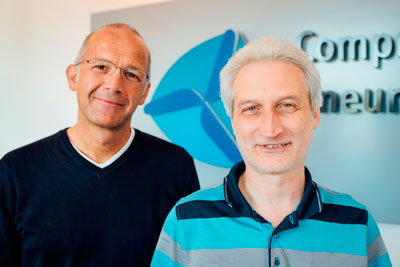| Posted: Jun 13, 2016 |
Lung Research - EU Horizon 2020 funding to predict nanotoxicity
(Nanowerk News) Scientists at the Helmholtz Zentrum München have received more than one million euros in the framework of the European Horizon 2020 Initiative. Dr. Tobias Stöger and Dr. Otmar Schmid from the Institute of Lung Biology and Disease and the Comprehensive Pneumology Center (CPC) will be using the funds to develop new tests to assess risks posed by nanomaterials in the airways. This could contribute to reducing the need for complex toxicity tests.
|
|
Nanoparticles are extremely small particles that can penetrate into remote parts of the body. While researchers are investigating various strategies for harvesting the potential of nanoparticles for medical applications, they could also pose inherent health risks (Journal of Aerosol Science, "Surface area is the biologically most effective dose metric for acute nanoparticle toxicity in the lung").
|
 |
| Dr. Tobias Stöger and Dr. Otmar Schmid. (Image: Helmholtz Zentrum München)
|
|
Currently the hazard assessment of nanomaterials necessitates a complex and laborious procedure. In addition to complete material characterization, controlled exposure studies are needed for each nanomaterial in order to guarantee the toxicological safety.
|
|
As a part of the EU SmartNanoTox project, which has now been funded with a total of eight million euros, eleven European research partners, including the Helmholtz Zentrum München, want to develop a new concept for the toxicological assessment of nanomaterials.
|
|
Reference database for hazardous substances
|
|
Biologist Tobias Stöger and physicist Otmar Schmid, both research group heads at the Institute of Lung Biology and Disease, hope that the use of modern methods will help to advance the assessment procedure. "We hope to make more reliable nanotoxicity predictions by using modern approaches involving systems biology, computer modelling, and appropriate statistical methods," states Stöger.
|
|
The lung experts are concentrating primarily on the respiratory tract. The approach involves defining a representative selection of toxic nanomaterials and conducting an in-depth examination of their structure and the various molecular modes of action that lead to their toxicity. These data are then digitalized and transferred to a reference database for new nanomaterials. Economical tests that are easy to conduct should then make it possible to assess the toxicological potential of these new nanomaterials by comparing the test results s with what is already known from the database. "This should make it possible to predict whether or not a newly developed nanomaterial poses a health risk," Otmar Schmid says.
|

